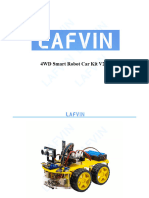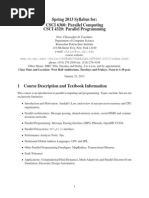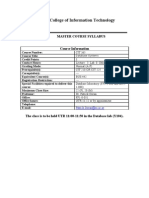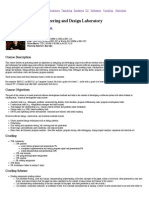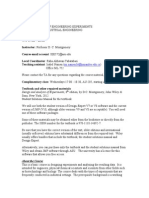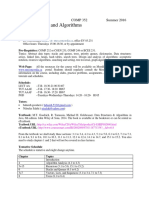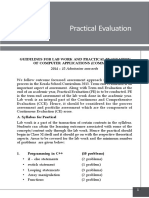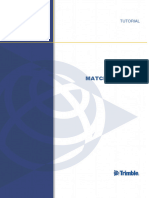Algorithms Project
Uploaded by
Møśtãfã MâhmøudAlgorithms Project
Uploaded by
Møśtãfã MâhmøudClass Project Protocols
Project Policy
Code must be original, and may not be copied or shared from any other source, except as provided by the class instructor Plagiarism will be very strictly punished
Project Submissions
Each project has associated with it a deadline due date. For each project, you should submit a zip file containing the following: o All source files o README.txt, containing documentation, analysis and other comments. (This could a plaintext or Word file) o You may read the input from a database file or excel file and show it in GUI directly. o If you have any, sample run outputs should be able to export it to an excel file and show it on the GUI as well.
Project Grading
Projects will be graded based on the following criteria:
Correctness -- the program system works according to project requirements o Source code o no syntax errors, no run-time errors, and the correct output must be produced o improper input gracefully handled, allocated space returned after it no longer is needed, and error-checking performed after calling any system or library function Testing, timing -- correct implementation of all functions needed for the complete project but not part of the project specifications o code needed for I/O o code needed for testing o code needed for timing Program structure -- well modularized, no gross inefficiencies (space or time) Internal documentation -- concise comments, indentation, descriptive variable names, explain "magic" numbers
o o o o o o README.txt/doc
how to use the program description of data structure implementation (some of this may be internal) theoretical time analysis of the underlying algorithms production of a function (based on your timing and analysis) to predict the time required by your system for larger instances of the problem accurate analysis of the space requirements
Algorithms Project (3rd Year) Efficient School Timetable/Exams
***** Due SUNDAY JAN 3 2011 *****
The school timetable problem that we are intended to solve in this project can be described as follows: In a department like computer engineering or a school of engineering in general, we suffer every semester from setting a suitable a timetable schedule for professors, classrooms, courses, and students as well as scheduling exams. The timetable/exam scheduling usually takes long time to be stabilized. The reason behind that is the hard and soft constraints that need to be taken into consideration during forming the timetable/exam scheduling. Although too much effort and time spent in scheduling, some of the professors as well as students complain about their schedule by the end of the day. Therefore, we want to make sure that our timetable/exams for the department/school is the best we could get and convince everybody by that. One way to do so is to automate the timetable generation process and just balm the computer for any inconvenience . Therefore, this is your job in this class. The following are description of what you need to do. In this project, we will study some of the important techniques and algorithms that are widely used in practice such as coloring algorithms and graph theory. Also, the intention behind this project is to design efficient algorithms and efficient software to solve hard problems. So, it is your responsibility to handle each and every issue related to the project efficiency in terms of design and software development. In addition to the timetable schedule, we want to utilize the similar components used for the timetable in scheduling exams as well. That enables 2X1 product. In addition to the efficiency of the used algorithms, a simple user interface is a must. Therefore, the following figures are samples to the required user interface.
Figure 1: Student Data Entrance
Figure 2 : Course Data Entrance
Figure 3: Course Registration Entrance
Figure 4 : Constraint Set
Figure 5: Resultant Timetable/Exams
Figure 6: Sample graph to the courses and their relation
Table 1: Conflict table
The cause for potential conflict could be any of the following example restrictions: Courses Calculus and Electronics might be taught by the same professor, Courses Microprocessors and Operating Systems might be taken by the same student.
Hard Constraints ( constraints that cannot be neglected and must be satisfied )
1234567A teacher can only teach in a single place at a time. A teacher can only give one lecture at a time. A room can only host one lecture at a time. A student can only attend one lecture at a time. No more than a teacher is scheduled to teach in a room each time. Every teacher must have scheduled all his/her hours. Every student must have scheduled all his/her hours.
Soft Constraints : (constraints over that we can pass sometimes but it is preferable not to do so and every time we violate them this fact is reflected on the overall efficiency of the timetable) 1. A teacher should not teach more than 6 hours a day. 2. A student should not have more than 8 hours a day. 3. There shouldn't be gaps in the activity of the teachers.
4. There shouldn't be gaps in the activity of the students.
Please note that there is a difference between Labs, tutorials, and Lectures. Also, TAs are assigned only to Labs and tutorials. The same rules are applied for exams when it is applicable; however, a student cannot have more than two exams per day. In addition, hard constraint #5 is relaxed for the exam schedule.
Guidelines Articles:
A Survey of Automated Timetabling Graph Coloring Conditions for the Existence of Solutions to the Timetable Problem A University Timetabling System based on Graph Colouring and Constraint Manipulation (Very important ) http://citeseerx.ist.psu.edu/viewdoc/summary?doi=10.1.1.95.3879 http://webdocs.cs.ualberta.ca/~joe/Coloring/#Graph.Colorers http://www.adaptivebox.net/CILib/code/gcpcodes_link.html http://shah.freeshell.org/graphcoloring/ http://www.emo.org.tr/ekler/76e76856c7fea3b_ek.pdf
Deliverables:
1- Survey on different solutions to the problem . 2- Justification to data structures and algorithms used . In other words , what data structures you used and why? 3- Source code of your implementation. 4- Readme file.
5- Some test cases of your design. 6- Hard and soft-copy report describing the used methods
Project Grading (100/105) 1) The project starts by designing a data structure to enter the courses and instructor requirements. A simple and efficient data structure and user interface is required. (8%) 2) A GUI and efficient data structure for the student registration are required. (8%) 3) GUI for setting the constraints (5%) 4) Visualizing the relation between the courses (9%) 5) Generating the conflict matrix (table) (10%) 6) Choosing and implementing the best coloring algorithm (20%) 7) Satisfying all hard and soft constraints (15%) 8) Generating the final tables (5%) 9) Considering the Exam schedule using the same coloring algorithm (15%) 10) Efficient programming (comments, documentation, structure, source code , etc.) (5%) 11) Final Report ( table of contents , Survey on the problem solutions , clear description to the data structure and algorithms used, test cases , performance measures to the algorithms and the running time of the software) (5%).
You might also like
- AP Computer Science Principles Premium, 2025: Prep Book with 6 Practice Tests + Comprehensive Review + Online PracticeFrom EverandAP Computer Science Principles Premium, 2025: Prep Book with 6 Practice Tests + Comprehensive Review + Online PracticeNo ratings yet
- Managing the Testing Process: Practical Tools and Techniques for Managing Hardware and Software TestingFrom EverandManaging the Testing Process: Practical Tools and Techniques for Managing Hardware and Software Testing4/5 (8)
- Microsoft Project 2013 Practical Exercises Pracs1to4 V2100% (4)Microsoft Project 2013 Practical Exercises Pracs1to4 V264 pages
- Project Synopsis For Automatic Timetable Generator76% (21)Project Synopsis For Automatic Timetable Generator7 pages
- Black Book On Automatic TimeTable Generator80% (5)Black Book On Automatic TimeTable Generator59 pages
- Programming Essentials by David. I. ACHEME Is Licensed Under ANo ratings yetProgramming Essentials by David. I. ACHEME Is Licensed Under A11 pages
- ENGG1811 Computing For Engineers (Semester 2, 2016)No ratings yetENGG1811 Computing For Engineers (Semester 2, 2016)8 pages
- COSC 2336, 01W, Data Structures and Algorithms: Instructor InformationNo ratings yetCOSC 2336, 01W, Data Structures and Algorithms: Instructor Information8 pages
- Data Flow Diagram of College Management System33% (3)Data Flow Diagram of College Management System8 pages
- Numerical Analysis 2020 - Fall - MEEN357 - SyllabusNo ratings yetNumerical Analysis 2020 - Fall - MEEN357 - Syllabus9 pages
- End of Course Memo CS 101 - Intro To Computing Aaron Bloomfield (Fall 2005)No ratings yetEnd of Course Memo CS 101 - Intro To Computing Aaron Bloomfield (Fall 2005)4 pages
- ORI 391Q.4 - Integer Programming Spring 2011 SyllabusNo ratings yetORI 391Q.4 - Integer Programming Spring 2011 Syllabus3 pages
- Course Outline CSC 588 Data Warehousing and Data Mining1No ratings yetCourse Outline CSC 588 Data Warehousing and Data Mining15 pages
- A Level (Including As Level) Computing (9691) Faqs: WWW - Amazon.Co - Uk WWW - Blackwells.Co - UkNo ratings yetA Level (Including As Level) Computing (9691) Faqs: WWW - Amazon.Co - Uk WWW - Blackwells.Co - Uk3 pages
- A computational approach to enhancing course timetabling with integer programmingNo ratings yetA computational approach to enhancing course timetabling with integer programming10 pages
- EE 461L Software Engineering and Design Laboratory: Miryung KimNo ratings yetEE 461L Software Engineering and Design Laboratory: Miryung Kim4 pages
- You Must Be Registered in One of The Following Lab SectionsNo ratings yetYou Must Be Registered in One of The Following Lab Sections3 pages
- "Routine Management System": Project Report OnNo ratings yet"Routine Management System": Project Report On26 pages
- Syllabus Final For IEE 572 Fall 2014 - Uniandes PDFNo ratings yetSyllabus Final For IEE 572 Fall 2014 - Uniandes PDF5 pages
- Superior University: Lesson Plan GuidelineNo ratings yetSuperior University: Lesson Plan Guideline17 pages
- Computer Organization and Assembly LanguageNo ratings yetComputer Organization and Assembly Language51 pages
- 25.353 - Computer Aided Engineering Design and AnalysisNo ratings yet25.353 - Computer Aided Engineering Design and Analysis6 pages
- Ve270 Introduction To Logic Design: Summer 2015No ratings yetVe270 Introduction To Logic Design: Summer 20154 pages
- Class Scheduling System Thesis Introduction100% (2)Class Scheduling System Thesis Introduction6 pages
- UT Dallas Syllabus For Se4381.001.07s Taught by David Russo (dtr021000)No ratings yetUT Dallas Syllabus For Se4381.001.07s Taught by David Russo (dtr021000)12 pages
- 15-418: Parallel Computer Architecture and Programming Spring 2011 SyllabusNo ratings yet15-418: Parallel Computer Architecture and Programming Spring 2011 Syllabus4 pages
- How to Track Schedules, Costs and Earned Value with Microsoft ProjectFrom EverandHow to Track Schedules, Costs and Earned Value with Microsoft ProjectNo ratings yet
- Autocad MFT V3.1 : Welcome To The MultifiletoolNo ratings yetAutocad MFT V3.1 : Welcome To The Multifiletool11 pages
- Qatar Strategic Transport Model (QSTM) - Oct 2013No ratings yetQatar Strategic Transport Model (QSTM) - Oct 201363 pages
- Class-Xii: Subject - Computer Science (083) Practical File Solution 2020-21 Objective & Solution 1No ratings yetClass-Xii: Subject - Computer Science (083) Practical File Solution 2020-21 Objective & Solution 136 pages
- Checking The Database Update Readiness-Atif - MobilyNo ratings yetChecking The Database Update Readiness-Atif - Mobily4 pages
- AP Computer Science Principles Premium, 2025: Prep Book with 6 Practice Tests + Comprehensive Review + Online PracticeFrom EverandAP Computer Science Principles Premium, 2025: Prep Book with 6 Practice Tests + Comprehensive Review + Online Practice
- Managing the Testing Process: Practical Tools and Techniques for Managing Hardware and Software TestingFrom EverandManaging the Testing Process: Practical Tools and Techniques for Managing Hardware and Software Testing
- Microsoft Project 2013 Practical Exercises Pracs1to4 V2Microsoft Project 2013 Practical Exercises Pracs1to4 V2
- Project Synopsis For Automatic Timetable GeneratorProject Synopsis For Automatic Timetable Generator
- Programming Essentials by David. I. ACHEME Is Licensed Under AProgramming Essentials by David. I. ACHEME Is Licensed Under A
- ENGG1811 Computing For Engineers (Semester 2, 2016)ENGG1811 Computing For Engineers (Semester 2, 2016)
- COSC 2336, 01W, Data Structures and Algorithms: Instructor InformationCOSC 2336, 01W, Data Structures and Algorithms: Instructor Information
- Numerical Analysis 2020 - Fall - MEEN357 - SyllabusNumerical Analysis 2020 - Fall - MEEN357 - Syllabus
- End of Course Memo CS 101 - Intro To Computing Aaron Bloomfield (Fall 2005)End of Course Memo CS 101 - Intro To Computing Aaron Bloomfield (Fall 2005)
- ORI 391Q.4 - Integer Programming Spring 2011 SyllabusORI 391Q.4 - Integer Programming Spring 2011 Syllabus
- Course Outline CSC 588 Data Warehousing and Data Mining1Course Outline CSC 588 Data Warehousing and Data Mining1
- A Level (Including As Level) Computing (9691) Faqs: WWW - Amazon.Co - Uk WWW - Blackwells.Co - UkA Level (Including As Level) Computing (9691) Faqs: WWW - Amazon.Co - Uk WWW - Blackwells.Co - Uk
- A computational approach to enhancing course timetabling with integer programmingA computational approach to enhancing course timetabling with integer programming
- EE 461L Software Engineering and Design Laboratory: Miryung KimEE 461L Software Engineering and Design Laboratory: Miryung Kim
- You Must Be Registered in One of The Following Lab SectionsYou Must Be Registered in One of The Following Lab Sections
- Syllabus Final For IEE 572 Fall 2014 - Uniandes PDFSyllabus Final For IEE 572 Fall 2014 - Uniandes PDF
- 25.353 - Computer Aided Engineering Design and Analysis25.353 - Computer Aided Engineering Design and Analysis
- UT Dallas Syllabus For Se4381.001.07s Taught by David Russo (dtr021000)UT Dallas Syllabus For Se4381.001.07s Taught by David Russo (dtr021000)
- 15-418: Parallel Computer Architecture and Programming Spring 2011 Syllabus15-418: Parallel Computer Architecture and Programming Spring 2011 Syllabus
- How to Track Schedules, Costs and Earned Value with Microsoft ProjectFrom EverandHow to Track Schedules, Costs and Earned Value with Microsoft Project
- Software Engineering & Object Oriented ModelingFrom EverandSoftware Engineering & Object Oriented Modeling
- Class-Xii: Subject - Computer Science (083) Practical File Solution 2020-21 Objective & Solution 1Class-Xii: Subject - Computer Science (083) Practical File Solution 2020-21 Objective & Solution 1
- Checking The Database Update Readiness-Atif - MobilyChecking The Database Update Readiness-Atif - Mobily

